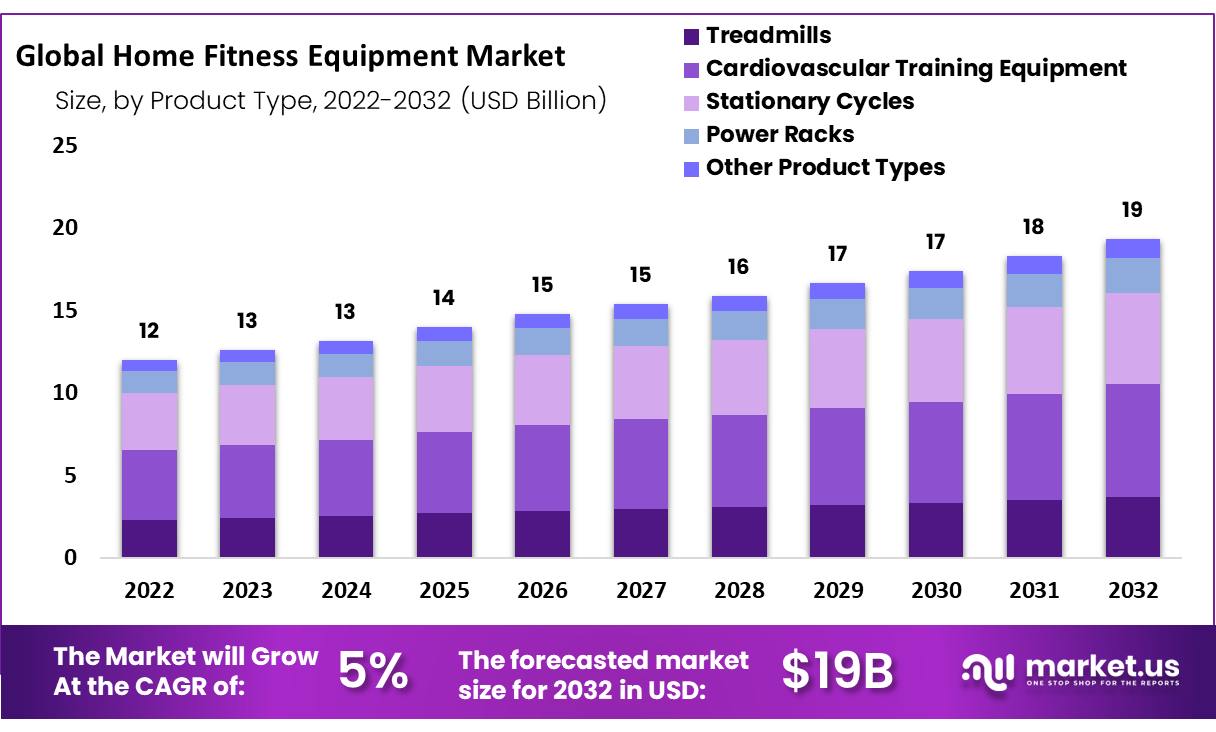Home Fitness Equipment Market To Grow Steadily With An Impressive CAGR Of 5% From 2022 To 2032: Market.us

Page Contents
Market Overview
Published Via 11Press : The home fitness equipment market has seen a significant uptick in demand over the past few years, with more and more people opting to work out from the comfort of their own homes. This trend has been accelerated by the COVID-19 pandemic, which forced many gyms and fitness studios to close temporarily, causing people to seek alternative ways of staying fit.
In 2022, the global home fitness equipment market accounted for USD 12 billion and is expected to grow to around USD 19 billion in 2032. Between 2023 and 2032, this market is estimated to register the highest CAGR of 5%.
The home fitness equipment market includes a wide range of products, from simple dumbbells and resistance bands to complex machines like treadmills, stationary bikes, and ellipticals. Sales of these products have skyrocketed in recent years as consumers become increasingly health-conscious and willing to invest in their physical well-being.
Request For Sample Report Here: https://market.us/report/home-fitness-equipment-market/request-sample/
One major trend within the home fitness equipment market is the rise of connected devices that allow users to track their workouts, set goals, and monitor progress through smartphone apps or other digital platforms. These devices have become increasingly popular as they provide greater flexibility for users while also allowing them to stay accountable and motivated toward achieving their fitness goals. With continued innovation within this space, it's likely that we'll continue seeing growth in the home fitness equipment market for years to come.

Key Takeaway
- North American home fitness market revenue gathered more than 45% market share in 2021
- According to our analysis, 54% of exercising Americans purchased fitness equipment
- Asia-Pacific home fitness market growth will record noteworthy CAGR during the forecast timeframe from 2022 to 2030
- Among applications, the female fertility segment accounted for over 70% of the overall market share in 2021
- The advent of the COVID-19 pandemic is a primary driver for home fitness equipment market growth
- The surge in online sales for fitness equipment fuels the home fitness devices market
Regional Snapshot
- North America: North America and especially its core market of the US accounts for an exceptional share in fitness-related equipment sales at home. There exists here an enormous popularity for health and fitness practices resulting in large populations with healthy practices; not to mention an adoption level of fitness practices among this population that ranks highly. Key drivers behind this growth in fitness equipment sales at home within this area include busy lives as well as rising popularity for fitness at home that have generated demand in this region.
- Europe: Europe is another critical market for home fitness equipment sales. Countries such as England, Germany, and France boast highly active health and fitness cultures with increasing numbers of individuals looking for convenient ways to exercise at home – with demand increasing for equipment like cardio machines as well as other fitness-related supplies in this region.
- Asia-Pacific Region: This area has experienced a substantial expansion of home health and fitness markets due to an influx of disposable income, urbanization, and changing lifestyle factors that fuel demand. Some countries such as China, India Japan as well as South Korea have witnessed an upswing in home exercise equipment like treadmills bikes as well as strength training equipment being purchased more regularly for personal fitness at home.
- Latin America: Latin America has emerged as one of the fastest-growing markets for home fitness equipment sales, particularly within Latin American nations like Brazil, Mexico, and Argentina. Increasing urbanization rates as well as the closure of gyms due to COVID-19 regulations for gyms in these regions and ease of exercise at home have created demand for home fitness equipment across their regions.
- Middle East and Africa: Middle Eastern and African states like United Arab Emirates, Saudi Arabia, and South Africa have seen the market for home fitness equipment explode recently due to rising disposable incomes as well as increasing emphasis on personal health and fitness as well as convenient exercise at home opportunities. Market growth here can be explained by factors including disposable income growth coupled with individuals emphasizing individual well-being while taking comfort in exercising from within their homes.
Directly Purchase a copy of the report | Quick Delivery Available – buy: https://market.us/purchase-report/?report_id=64783
Drivers
- Convenience and Time-Saving: home fitness equipment provides the convenience of working out at any time without the need to travel to a gym or fitness center. It saves time and offers flexibility to individuals with busy schedules, making it a preferred choice for many.
- Growing Health and Wellness Consciousness: The increasing awareness of the importance of physical fitness and overall well-being is driving the demand for home fitness equipment. People are becoming more health-conscious and seeking ways to incorporate regular exercise into their daily routines.
- Technological Advancements: Technological advancements in the fitness equipment industry, such as interactive displays, smart connectivity, virtual training, and wearable technology integration, have enhanced the user experience and made-at-home workouts more engaging and effective.
- Impact of the COVID-19 Pandemic: The COVID-19 pandemic has significantly impacted the fitness industry, with gym closures and social distancing measures leading to a surge in demand for home fitness equipment. Many individuals turned to home workouts as a safe and convenient alternative to traditional gym settings.
Restraints
- High Initial Costs: Some home fitness equipment can be expensive, especially high-end models or specialized equipment. The initial investment required for purchasing fitness equipment can be a deterrent for some individuals, limiting their ability to participate in at-home workouts.
- Limited Space: home fitness equipment typically requires dedicated space, which may be a constraint for individuals living in small apartments or houses. Limited space availability can restrict the type and size of equipment that can be accommodated, impacting the purchasing decision.
Opportunities
- Increasing Adoption of E-Commerce: The rise of e-commerce platforms has made it easier for consumers to explore and purchase home fitness equipment. Online sales channels provide a broader reach and convenience, allowing customers to compare products, read reviews, and make informed purchasing decisions.
- Personalized Fitness Solutions: The home fitness equipment market presents an opportunity for companies to offer personalized fitness solutions. This includes providing tailored workout programs, integrating artificial intelligence (AI) or machine learning algorithms for customized training, and incorporating virtual coaching or training sessions.
Make an inquiry before picking up this report @ https://market.us/report/home-fitness-equipment-market/#inquiry
Challenges
- Lack of Guidance and Accountability: One challenge with home fitness equipment is the absence of in-person trainers or instructors who can provide guidance, correction, and motivation. Some individuals may struggle to stay motivated or maintain proper form without professional supervision.
- Long-Term Adherence: A significant challenge for individuals using home fitness equipment is maintaining long-term adherence to exercise routines. Without external accountability or a social environment like a gym, some people may find it challenging to sustain their motivation and commitment to regular workouts.
- Competition from Alternative Fitness Solutions: home fitness equipment faces competition from alternative fitness solutions such as fitness apps, on-demand workout videos, and virtual fitness classes. These options often offer a wide range of workouts without the need for specialized equipment, making them attractive to budget-conscious consumers.
- Storage and Maintenance: home fitness equipment requires proper storage and maintenance to ensure its longevity and optimal performance. Some individuals may face challenges in finding adequate storage space or may not be inclined to perform regular maintenance tasks, which can affect the usability and durability of the equipment.
Key Players
- Johnson Health Tech Co. Ltd.
- Icon Health & Fitness, Inc.
- Fitness World AS
- Amer Sports Corporation
- Core Health & Fitness, LLC
- Nordic Track
- ProForm
- Hoist Fitness Systems
- Nautilus, Inc.
- Other Key Players
Key Segmentation
By Product Type
- Treadmills
- Cardiovascular Training Equipment
- Stationary Cycles
- Power Racks
- Other Product Types
By Distribution Channel
- Online Platforms
- Offline Stores
By End-User
- Households
- Gym in Apartments
- Apartments
Top Impacting Factors
- Increasing Health and Wellness Consciousness: There is a growing emphasis on personal health and wellness globally. Individuals are becoming more conscious of the importance of regular exercise and physical fitness, leading to an increased demand for home fitness equipment.
- Convenience and Time-Saving: Home fitness equipment provides the convenience of working out at any time without the need to travel to a gym or fitness center. It saves time and offers flexibility to individuals with busy schedules, making it an attractive option for many.
- Technological Advancements: Technological advancements in home fitness equipment have improved user experiences and made workouts more engaging and effective. Features such as interactive displays, virtual training, wearable technology integration, and fitness tracking capabilities enhance the overall workout experience and motivate individuals to exercise at home.
- Impact of the COVID-19 Pandemic: The COVID-19 pandemic has significantly impacted the home fitness equipment market. Gym closures and social distancing measures have led to a surge in demand for home fitness solutions. Many individuals turned to home workouts as a safe and convenient alternative to traditional gym settings, accelerating the adoption of home fitness equipment.
- E-commerce and Online Retail Channels: The rise of e-commerce and online retail platforms has made it easier for consumers to explore and purchase home fitness equipment. Online sales channels provide a wider range of product options, competitive pricing, and convenience, driving the growth of the market.
Recent Developments
- In August 2021– Matrix Fitness South Africa was developed by Johnson Health Tech Co. Ltd. Previously it is a distributor for JHT. Thus, Johnson Health Tech Co. Ltd. became the first company that has its own subsidiary in Africa. Also, the main strategy behind it was to enhancement of the businesses in the African region. This will result in the growth of the market.
- In June 2021– ICON Health & Fitness declared that its changed name i.e. iFIT Health & Fitness Inc. (iFIT). As per this firm, the change reflects the commitment of iFIT to delivering personalized, connected health and fitness experiences to its increasing community. Presently, I have above 5 million members in 120 countries.
Report Scope
| Report Attribute | Details |
| The market size value in 2022 | USD 12 Bn |
| Revenue Forecast by 2032 | USD 19 Bn |
| Growth Rate | CAGR Of 5% |
| Regions Covered | North America, Europe, Asia Pacific, Latin America, and Middle East & Africa, and Rest of the World |
| Historical Years | 2017-2022 |
| Base Year | 2022 |
| Estimated Year | 2023 |
| Short-Term Projection Year | 2028 |
| Long-Term Projected Year | 2032 |
Frequently Asked Questions
Q: What is the current size of the Home Fitness Equipment Market?
A: The Global Home Fitness Equipment Market size is USD 12 Billion in 2022.
Q: What is the projected growth rate for Home Fitness Equipment Market?
A: The Home Fitness Equipment Market is expected to grow at a CAGR of 5% from 2023 to 2032.
Q: What are some of the key players in the Home Fitness Equipment Market?
A: Some of the key players in the Home Fitness Equipment market include Johnson Health Tech Co. Ltd., Icon Health & Fitness, Inc., Fitness World AS, Amer Sports Corporation, Core Health & Fitness, LLC, Nordic Track, ProForm, Hoist Fitness Systems, Nautilus, Inc., Other Key Players.
Contact:
Global Business Development Team – Market.us
Market.us (Powered by Prudour Pvt. Ltd.)
Send Email: [email protected]
Address: 420 Lexington Avenue, Suite 300 New York City, NY 10170, United States
Tel: +1 718 618 4351
Website: https://market.us/
Content has been published via 11press. for more details please contact at [email protected]
The team behind market.us, marketresearch.biz, market.biz and more. Our purpose is to keep our customers ahead of the game with regard to the markets. They may fluctuate up or down, but we will help you to stay ahead of the curve in these market fluctuations. Our consistent growth and ability to deliver in-depth analyses and market insight has engaged genuine market players. They have faith in us to offer the data and information they require to make balanced and decisive marketing decisions.



